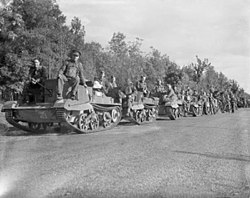| British Expeditionary Force | |
|---|---|
 Bren carriers of the 13/18th Royal Hussars during an exercise near Vimy, 11 October 1939 | |
| Active | 2 September 1939 – 31 May 1940 |
| Disbanded | 1940 |
| Country | Britain |
| Branch | Army |
| Type | Expeditionary Force |
| Role | Field operations in France and the Low Countries |
| Size | 390,000[1] 13 divisions (maximum) |
| Part of | 1re groupe d'armées (1st Army Group) Front du Nord-est (North-Eastern Front) |
| Commanders | |
| Notable commanders | John Vereker, 6th Viscount Gort (Lord Gort) |
The British Expeditionary Force (BEF) was the contingent of the British Army sent to France in 1939 after Britain and France declared war on Nazi Germany on 3 September, beginning the Second World War. The BEF existed from 2 September 1939 when the BEF GHQ was formed until 31 May 1940, when GHQ closed down and its troops reverted to the command of Home Forces. During the 1930s, the British government had planned to deter war by abolishing the Ten Year Rule and rearming from the very low level of readiness of the early 1930s. The bulk of the extra money went to the Royal Navy and the Royal Air Force but plans were made to re-equip a small number of Army and Territorial Army divisions for service overseas.
General Lord Gort was appointed to the command of the BEF on 3 September 1939 and the BEF began moving to France on 4 September 1939. The BEF assembled along the Belgian–French border. The BEF took their post to the left of the French First Army under the command of the French 1st Army Group (fr:Groupe d'armées n° 1) of the North-Eastern Front (Front du Nord-est). Most of the BEF spent the Phoney War (3 September 1939 to 9 May 1940) digging field defences on the border. When the Battle of France (Fall Gelb) began on 10 May 1940, the BEF constituted 10 per cent of the Allied forces on the Western Front.
The BEF participated in the Dyle Plan, a rapid advance into Belgium to the line of the Dyle River, but the 1st Army Group had to retreat rapidly through Belgium and north-western France, after the German breakthrough further south at the Battle of Sedan (12–15 May). A local counter-attack at the Battle of Arras (1940) (21 May) was a considerable tactical success but the BEF, French and Belgian forces north of the Somme River retreated to Dunkirk on the French North Sea coast soon after, British and French troops being evacuated in Operation Dynamo (26 May – 4 June) to England after the capitulation of the Belgian army.
Saar Force, the 51st (Highland) Infantry Division and reinforcements, had taken over part of the Maginot Line for training. The force fought with local French units after 10 May, then joined the Tenth Army south of the Somme, along with the improvised Beauman Division and the 1st Armoured Division, to fight in the Battle of Abbeville (27 May – 4 June). The British tried to re-build the BEF with Home Forces divisions training in Britain, troops evacuated from France and lines-of-communications troops south of the Somme river (informally known as the 2nd BEF) but BEF GHQ was not reopened.
After the success of the second German offensive in France (Fall Rot), the 2nd BEF and Allied troops were evacuated from Le Havre in Operation Cycle (10–13 June) and the French Atlantic and Mediterranean ports in Operation Aerial (15–25 June, unofficially to 14 August). The Navy rescued 558,032 people, including 368,491 British troops but the BEF lost 66,426 men of whom 11,014 were killed or died of wounds, 14,074 wounded and 41,338 men missing or captured. About 700 tanks, 20,000 motor bikes, 45,000 cars and lorries, 880 field guns and 310 larger equipments, about 500 anti-aircraft guns, 850 anti-tank guns, 6,400 anti-tank rifles and 11,000 machine-guns were abandoned. As units arrived in Britain they reverted to the authority of the Commander-in-Chief, Home Forces.
- ^ "Defeat in the West, 1940". National Army Museum. Retrieved 25 August 2020.